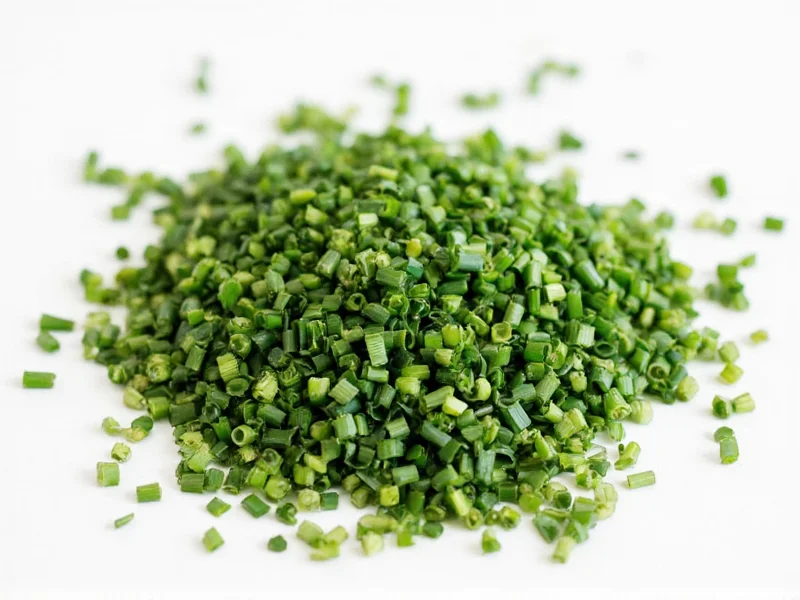When you're in the middle of cooking and realize you've run out of dried chives, knowing the right substitute can save your recipe. Dried chives provide a mild onion flavor with subtle garlic notes, making them popular in dips, soups, and potato dishes. The ideal replacement depends on your specific culinary application and what ingredients you have available.
Why Substitution Ratios Matter
Dried herbs are more concentrated than fresh varieties because the drying process removes water content while intensifying flavors. When substituting, understanding proper ratios prevents your dish from becoming overpowering or bland. Most dried-to-fresh herb conversions follow a 1:3 ratio, but chives require special consideration due to their delicate flavor profile.
Top Substitutes for Dried Chives Ranked
Not all substitutes work equally well in every recipe. Here's how common alternatives compare based on flavor match, texture, and culinary versatility:
| Substitute | Ratio (vs Dried Chives) | Best For | Flavor Match | Texture Match |
|---|---|---|---|---|
| Fresh chives | 3:1 | Dips, salads, garnishes | ★★★★★ | ★★★☆☆ |
| Green onions (scallions) | 2:1 (green parts only) | Soups, stir-fries, baked potatoes | ★★★☆☆ | ★★★☆☆ |
| Chive powder | 1:1 | Dry rubs, spice blends | ★★★★☆ | ★★★★★ |
| Onion powder | 1:2 | Meatloaf, casseroles, sauces | ★★☆☆☆ | ★★★★★ |
| Shallots (minced) | 1.5:1 | Cream sauces, dressings | ★★★☆☆ | ★★☆☆☆ |
Fresh Chives: The Closest Flavor Match
Fresh chives provide the most authentic flavor replacement when substituting for dried chives. Use three times the amount of fresh chives compared to the dried quantity called for in your recipe. For example, if a recipe requires one teaspoon of dried chives, use one tablespoon of finely chopped fresh chives.
Best applications for fresh chives include:
- Cold dishes like potato salad where heat won't diminish their delicate flavor
- Garnishing finished dishes for visual appeal and fresh flavor
- Dips and spreads where texture matters less than flavor
Remember that fresh chives lose their distinctive flavor when exposed to high heat for extended periods, making them less suitable for long-simmering soups or stews.
Green Onions: The Practical Pantry Alternative
When fresh chives aren't available, green onions (scallions) offer the next best option. Use only the green parts for substitution, as the white portions have a stronger onion flavor that differs significantly from chives. The recommended ratio is two parts green onion tops for every one part dried chives.
Green onions work particularly well as a substitute for dried chives in:
- Cream of potato soup recipes
- Baked potato toppings
- Asian-inspired dishes where their mild flavor complements other ingredients
For the best results, finely mince the green portions and add them toward the end of cooking to preserve their fresh flavor.
Dry Herb Alternatives for Pantry Solutions
When you need a dry substitute that matches the texture of dried chives, consider these options:
Chive Powder
Chive powder provides the closest match in both flavor and texture, allowing for a straightforward 1:1 substitution. This is particularly useful when making dry spice blends or rubs where texture consistency matters.
Onion Powder
Use half the amount of onion powder compared to the dried chives called for in your recipe. While the flavor profile differs slightly (more pronounced onion taste), it works well in heartier dishes like meatloaf, casseroles, and cheese spreads. This substitute for dried chives in dip recipes maintains the expected texture while providing complementary flavor.
Specialty Substitutes for Specific Applications
Certain recipes benefit from more specialized substitutions:
Shallots for Creamy Dishes
Finely minced shallots (at a 1.5:1 ratio) work exceptionally well as a substitute for dried chives in creamy sauces and dressings. Their mild, sweet onion flavor with subtle garlic notes closely resembles chives when cooked gently in dairy-based sauces.
Dill in Scandinavian-Inspired Recipes
For dishes with Nordic influences, dill can serve as an acceptable substitute at a 1:1 ratio. While the flavor profile differs, both herbs share similar applications in fish dishes, egg preparations, and potato salads. This works particularly well as a substitute for dried chives in salmon recipes.
What NOT to Use as Substitutes
Certain common pantry items make poor substitutes for dried chives:
- Garlic powder (overpowering flavor that dominates dishes)
- Regular onions (too strong and alters texture significantly)
- Chives flowers (beautiful but lack concentrated flavor of dried chives)
Using these inappropriate substitutes often results in dishes that taste completely different from what the recipe intended, particularly problematic when making delicate sauces or light-flavored soups.
Storage Tips for Substitutes
Maximize the shelf life of your substitute ingredients:
- Fresh chives: Store in a glass of water in the refrigerator, covered with a plastic bag
- Green onions: Wrap in damp paper towel inside airtight container
- Dry substitutes: Keep in airtight containers away from heat and light
Proper storage extends the usability of your substitutes, ensuring you're prepared when you need a replacement for dried chives in future recipes.
Final Considerations for Perfect Substitution
The key to successfully replacing dried chives lies in understanding your specific recipe requirements. For cold dishes or finishing touches, fresh alternatives work best. For cooked dishes requiring dry ingredients, powder substitutes maintain the expected texture. Always consider adding substitute ingredients at the appropriate cooking stage—delicate fresh herbs near the end, dry substitutes earlier in the process.











 浙公网安备
33010002000092号
浙公网安备
33010002000092号 浙B2-20120091-4
浙B2-20120091-4